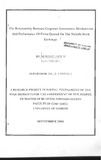| dc.description.abstract | The objectives of the study were to investigate the relationship between corporate governance mechanisms and firm performance in Kenyan publicly quoted firms and also to document the corporate governance mechanisms present in these companies. In order to achieve these objectives, both descriptive statistics analysis and cross sectional multiple regression analysis are done for 44 companies quoted on the Nairobi stock exchange in the period of 1999-2003. The following major conclusions are drawn from the study.
The average board size of Kenyan listed firm is 8 and nt*.-executives hold a significantly larger percentage of board seats (76%). In addition, 0.13% of the sample population have C.E.O. duality. With regard to ownership, the five largest shareholders in Kenyan listed firms account for 70% of the outstanding shares on average while Institutional investors, individual investors, foreign investors, financial institudons, and the state control 51%, 22%, 26%, 10% and 3.4% of the outstanding shares respectively.
Empirical results of the study show that both board size and C.E.O. duality have significant relationships only with stock market returns (RET). They have a positive and negative relationship respectively. No measure of firm performance has a significant relationship with the percentage of non-executive board members. With regard to ownership structure, state ownership is negatively related to return on assets (ROA) but has no significant relationship with RET and Tobin’s Q ratio. State share ownership seems to lead to inefficiency and low profitability. Financial institutions ownership is positively related to Tobin’s Q but has no significant relationship with RET and ROA. This supports the hypothesis that financial institutions have the skills and resources to monitor managers.
Ownership by top 5 shareholders, which depicts ownership concentration, is not significantly related to any of the performance measures. Also ownership by individuals and institutional investors are not significantly related to any of the performance measures. With regard to control variables, the use of leverage has a significant negative relationship only with ROA, While firm size is related positively only with RET.
The fact that different performance measures exhibit different results with various corporate governance mechanisms confirm why debate has ensued on which of the measures; stock market or accounting is “best” for studies about corporate governance without consensus. | en_US |



